Hunting chicken of the woods is an absolute thrill.
These mouth-watering mushrooms make a wonderful addition to any supper, boasting a variety of vital nutrients and just a hint of lemony sweetness.
Want to try them out for yourself? I can’t blame you!
Read on for a comprehensive guide to chicken of the woods identification, including various species you may encounter and look-alikes to avoid in the field.
How to Identify Chicken of the Woods
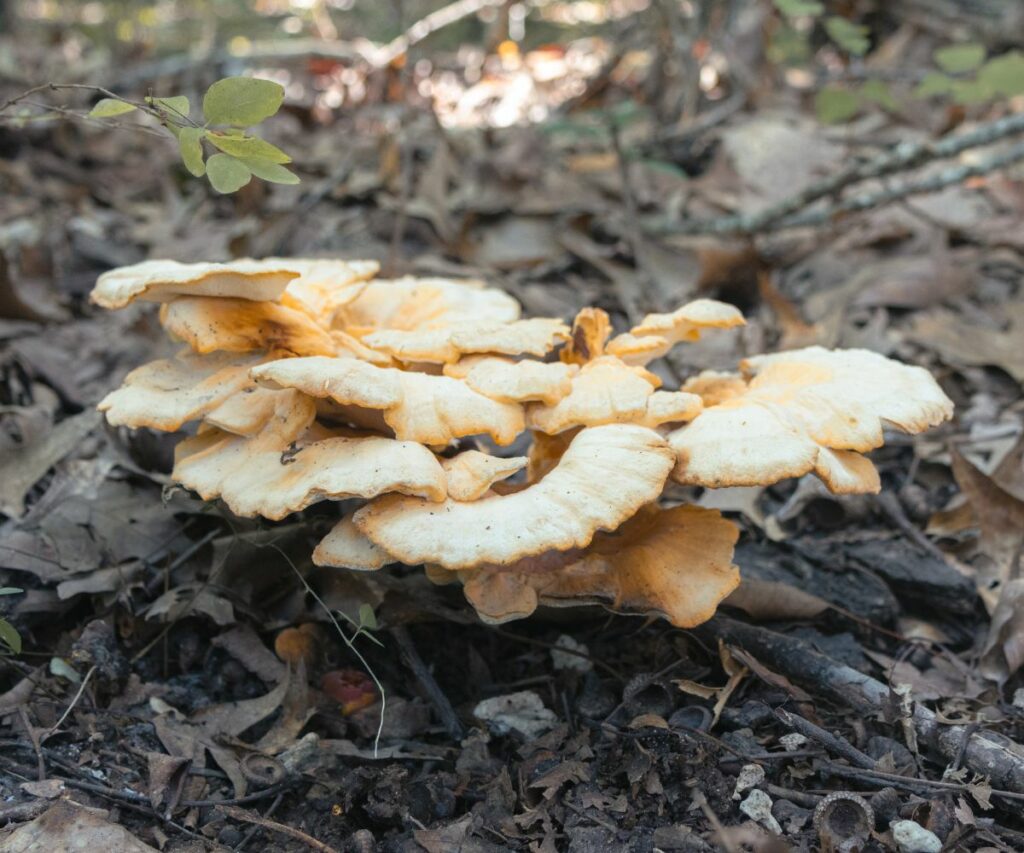
Chicken of the woods are polypore bracket mushrooms in the exclusive Laetiporus genus. These large, flamboyant fungi are characterized by bright orange and yellow hues that contrast sharply with the usual muted browns and greens of a forest. They are easy to spot and identify, making them the perfect mushroom for newbie foragers.
Appearance
Chicken of the woods stands out in size as well as color. Some specimens might grow six or seven inches across, but many reach several feet. This is no small fry fungi — the largest recorded specimen weighed 100 pounds.
Of course, there are other big, bright mushrooms vying for your attention. To positively identify a mushroom as chicken of the woods, you’ll need to examine the following characteristics and make sure they match up:
- Cap: Caps can be irregular, blobby, or flat, fanning out in a kidney shape or semicircle. They grow in shelves of stacked brackets or rosettes with bright orange, red, pinkish, or yellow coloring. Caps can be multicolored or zonate with white around the margins. Margins are lobed and may appear wavy or sharp.
- Pore surface: The pore surface can be white, cream colored, or yellow, depending on the species. The pores are very small.
- Stalk: Chicken of the woods has no true stalk. It grows in shelves directly from hardwood or attaches at a fleshy, stumpy stem.
- Flesh: The flesh is white, pale yellow, cream colored, or pinkish.
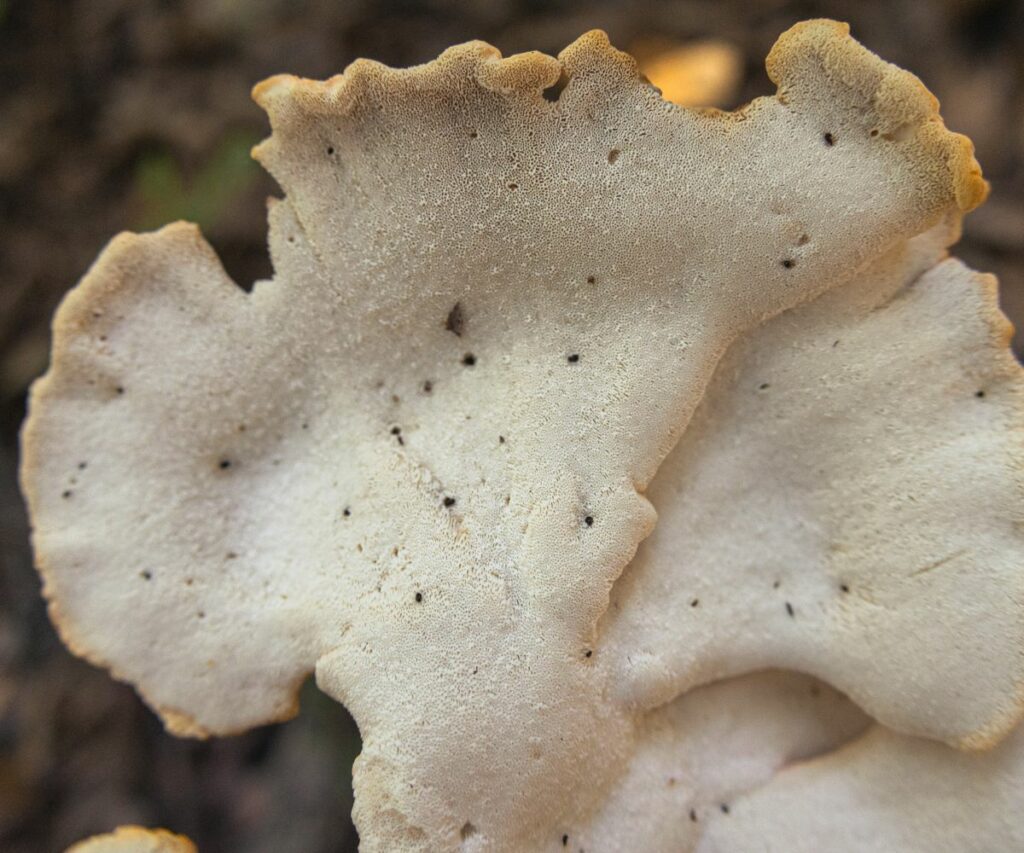
Species
We have seven Laetiporus species occurring here in the US, all varying in appearance and habitat. You might have several different species growing in your region, which can cause some confusion when trying to make an ID.
But what these Laetiporus species have in common is that they are all delicious. It’s essential to familiarize yourself with each species so you don’t pass up a perfect specimen because it looks different than others you’ve seen.
- Laetiporus sulphureus: Also known as a “sulfur shelf,” this chicken grows in stacked shelves directly from the decaying bark of oaks and other hardwoods. It is known for its bright, zonate orange or red coloring and has a yellow pore surface. It is widely distributed in the eastern US.
- Laetiporus cincinnatus: This chicken causes root rot and usually grows from a tree’s base rather than the bark itself, primarily populating oak and other hardwood. It develops in beautiful stacked rosettes instead of shelves, with a lighter peach color and white pore surface. It is widely distributed in the east.
- Laetiporus gilbertsonii: This species appears similar to L. sulphureus but grows in the western half of the nation, primarily on eucalyptus trees.
- Laetiporus gilbertsonii var. pallidus: This species is similar to L. gilbertsonii but has a white pore surface. It grows along the Gulf Coast in tropical and subtropical climates on many kinds of trees, including palm.
- Laetiporus conifericola: This species occurs between California and Alaska. It grows on conifer trees, with a peach cap and pore surface, eventually fading to pale yellow or white around the margins.
- Laetiporus huroniensis: Bright orange caps and yellowish pores characterize this species, which grows on fallen conifers in the northeast part of the country.
- Laetiporus persicinus: Known as the “white chicken,” this species has pale caps that fade to yellow and eventually brown. It grows in the southeast from all types of trees, and its pore surface bruises brown when scratched.
Important Reaction Notice
Chicken of the woods is one of those wild fungi that may cause gastrointestinal distress when consumed. Species growing on evergreen trees seem to cause this reaction more than species growing on hardwoods, but I cannot find any definitive research to back up the claim that these species are toxic.
Avoid harvesting from evergreens if you are concerned with the prospect of digestive distress or are particularly sensitive. If it’s your first time eating chicken of the woods, trying only a small piece of thoroughly cooked fungus is best. Wait 24 hours to see if you react.
Texture, Taste, and Smell
Touching your chicken is the best way to get familiar with it. When young, fresh, and ready to be picked, these mushrooms have a spongy texture. They should feel soft and may have a velvety sheen on the caps. When you pick a prime specimen, it exudes a sappy white or yellow substance. I like to call this “mushroom milk,” and it’s a sign of youth and vitality.
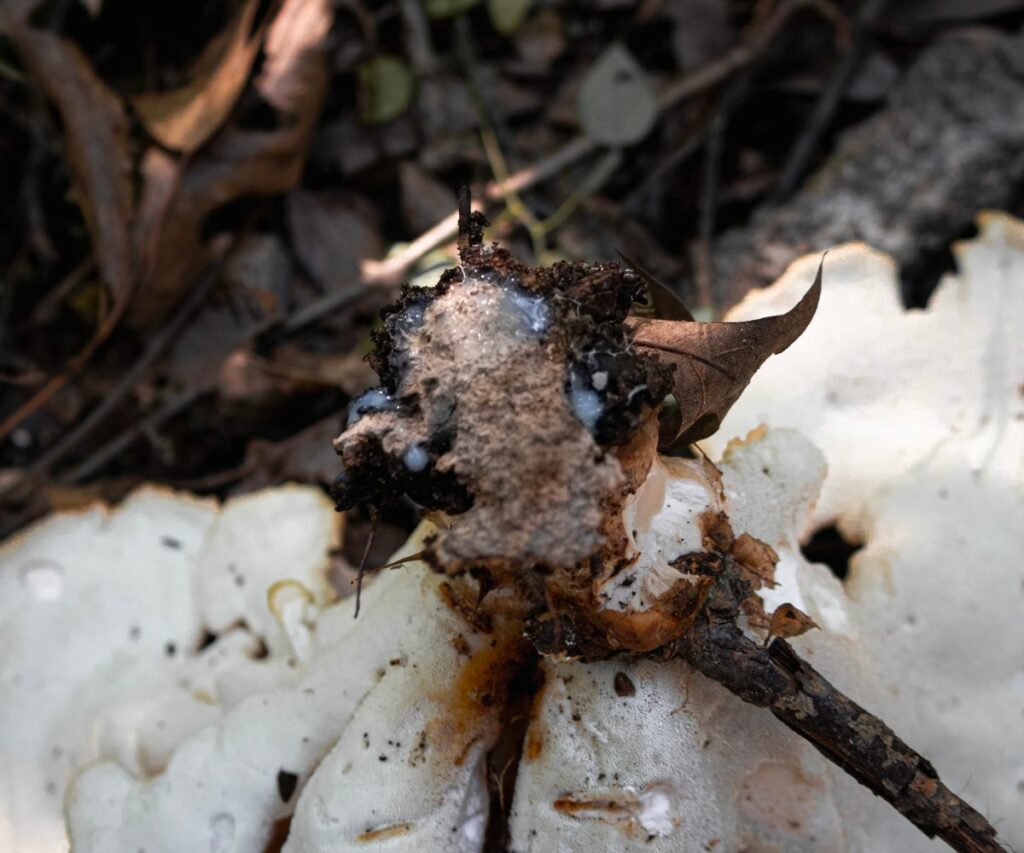
Fruits will bend when you apply pressure but won’t break unless you snap them in half. You can tear the cap easily, and it will come off in soft, fibrous strips. When you sniff it, you’ll notice that this fragrant fungus has an earthy, slightly sweet smell.
Chicken of the woods was named for its flavor profile. It has a mellow taste that soaks up the flavor of whatever dish you cook and a light, fibrous consistency like chicken. You can easily sub it out when preparing chicken strips or nuggets or use it as a base for sauces and mushroom jerky.
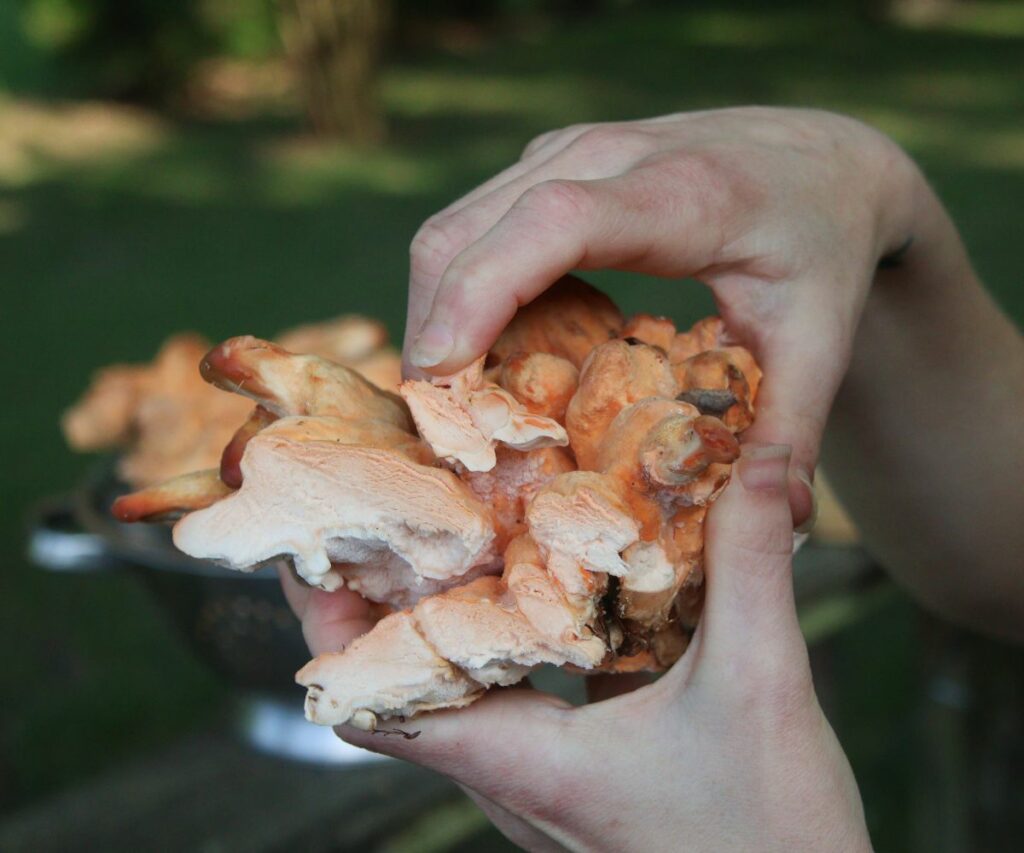
Habitat
Like reishi mushrooms, Laetiporus species can be a decomposing saprobe or a parasitic fungus that feeds off living trees. This cool but confusing feature enables the fungus to occupy a wide range of habitats. While it grows primarily in old-growth forests, you can occasionally find it on roadsides or developed areas.
Identifying chicken of the woods by appearance is much more reliable than by habitat or host tree.
With so many different species, this mushroom occurs on pretty much any type of tree. It may appear on living trees, dead trees, fallen trees, tree bases, or root systems. It can even appear to grow right from the ground, though you can rest assured it’s got its little mycelium fingers wrapped around some buried tree matter.
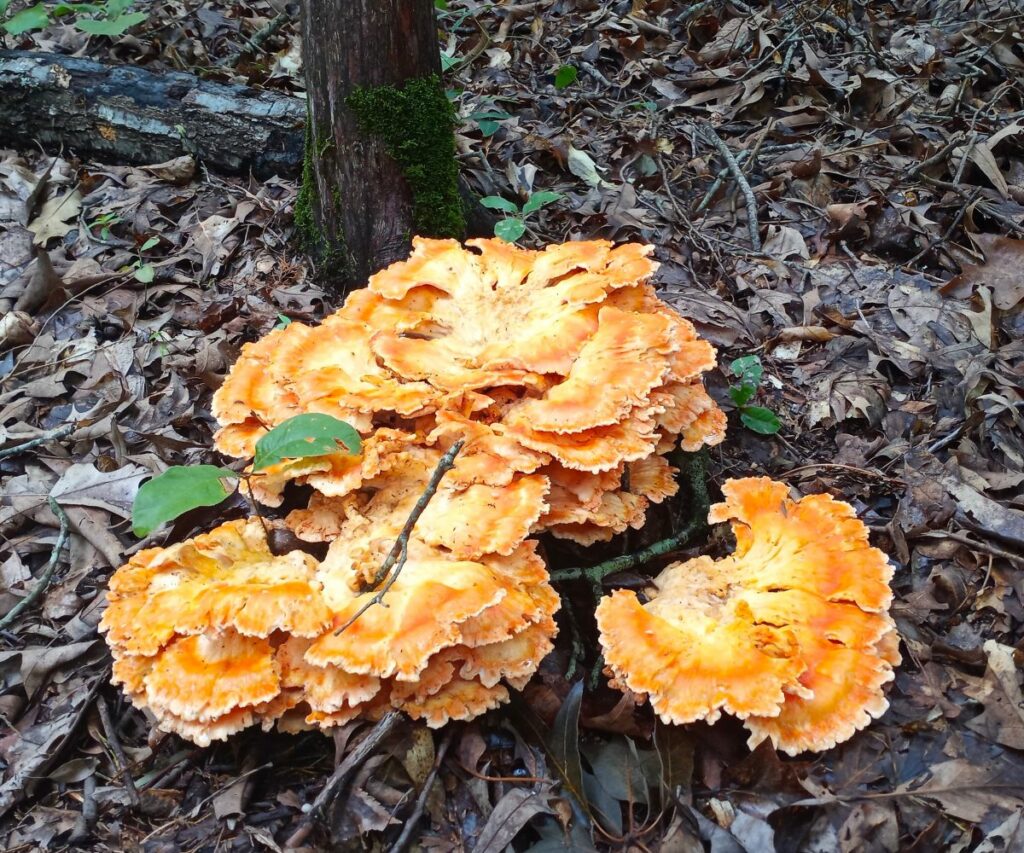
Chicken of the woods’ habitat can be chaotically variable, but nature has infused it with a certain reliability to compensate for this. Once you find one, you’ve found a honey hole. These mushrooms appear in the same place yearly, returning in the summer like clockwork. They will continue to appear until no more food is left for them and the tree has completely rotted away.
Growing Conditions
Young chicken of the woods sprout from the base of trees in knobby, stalky fingers. When growing from bark, its bulbous protrusions seem to ooze from woody cracks like an alien growth. It grows quickly once visible, with specimens flattening out to brackets and reaching prime in under a week, depending on the weather and conditions.
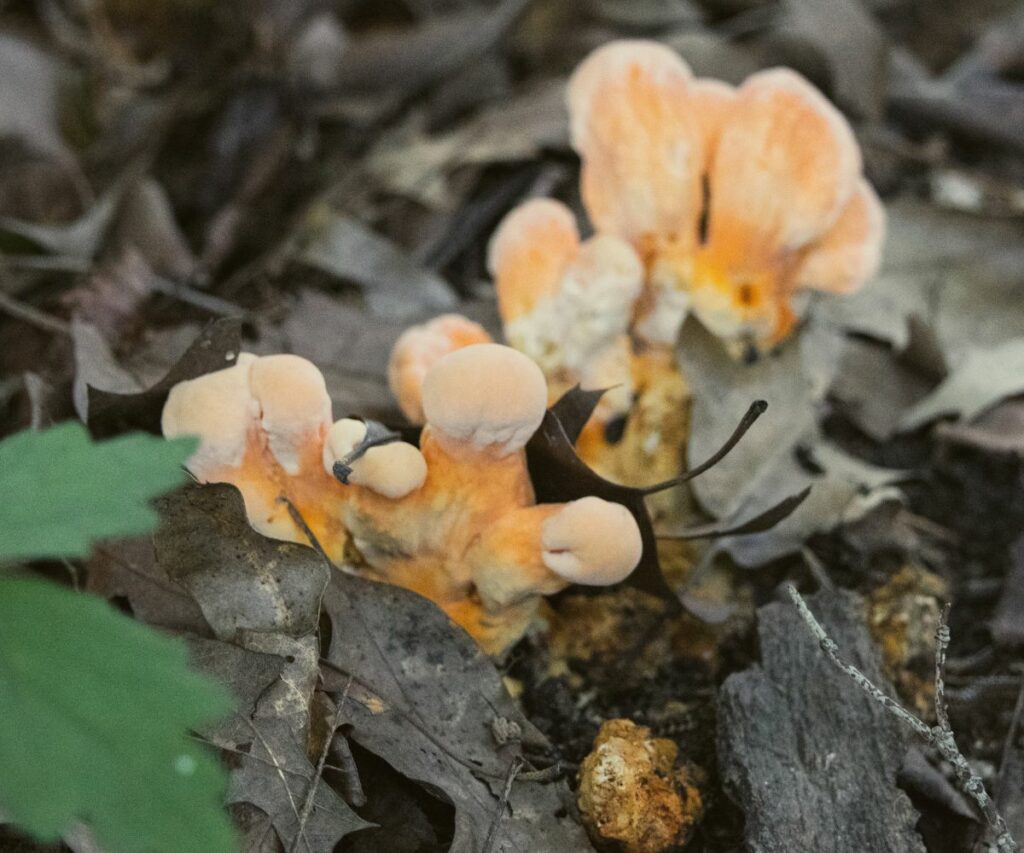
Prime doesn’t hold for long. Chicken of the woods will dry out and become chalky and bitter after a few days. Alternatively, it will become waterlogged and disintegrate into a gloopy mess. You must also compete with the wildlife to claim a prime specimen before they do.
Woodland creatures and insects can recognize a good thing. They quickly flock to choice chickens, eating away at the flesh until nothing is left. A few worms and squirrel nibbles won’t hurt you, and you should always clean foraged items anyway. However, avoiding overly buggy or chewed-up specimens is wise.
Season
Chicken of the woods craves heat and humidity. It often appears later in the summertime when warm weather has held for some time, with July through September being prime chicken time. When the weather is truly brutal, I have found them as early as April and as late as November. You might find them outside these months, depending on your climate.
Chickens are particularly prolific after periods of stable sunshine and adequate rain, but they aren’t as fussy as species like chanterelles. While they aren’t drought resistant, you’ll still be able to find them when other summer fungi have shriveled up and died. That being said, chicken is not a competitive species. It may die off in the presence of stronger mycelium, so pay close attention to where it grows.
Chicken of the Woods ID Check
- Bright yellow, orange, or salmon caps
- Zonate, multicolored, or monochrome caps
- White, yellow, or pinkish pore surface
- Shelving brackets or rosettes
- Growing from tree trunks or bases
Recognizing Common Look-Alikes
Velvet-Top Fungus
Known in the scientific community as Phaeolus schweinitzii, velvet-top fungus looks quite similar to chicken of the woods when young. Immature specimens feature bright orange and yellow caps with high visibility in the forest, causing many a forager to rush over in excitement only to groan in disappointment.
These fakers often appear in fan shapes, with large, irregular lobes sprouting from a single false stem. They can also form brackets directly on trees, much like chicken of the woods, but they are a root-rot fungus — so it’s much more common to find them growing from the base of a tree.
You can distinguish velvet-top fungus by the color of its flesh. While chicken of the woods has soft, pale flesh, velvet tops have dark flesh and a rough, woody texture. They don’t smell appetizing. Their caps turn dark brown with age, making them much easier to tell apart.
If you find it: Leave it be, or get creative! Velvet-top fungus is also known as Dyer’s polypore because you can extract its coloring to make beautiful yellow dyes.
Chanterelle Mushroom
I’ve covered these mushrooms extensively in my chanterelle identification guide. Chanterelles are very different from chickens, but they can easily trip up novices from afar. These puppies appear bright yellow or orange, just like chicken of the woods, and often grow near the base of hardwood trees.
A quick examination will set you straight. Chanterelles are smaller, with trumpet-shaped caps that funnel down in the center. The pore surface is colorful and features false gills that snake across the underside of the cap. You’ll never find a chanterelle growing from a tree; they grow from the ground and have a true stem.
If you find it: Harvest it for your foraging bag. Chanterelles are a choice edible during the summertime, and some people even prefer them to chicken of the woods!
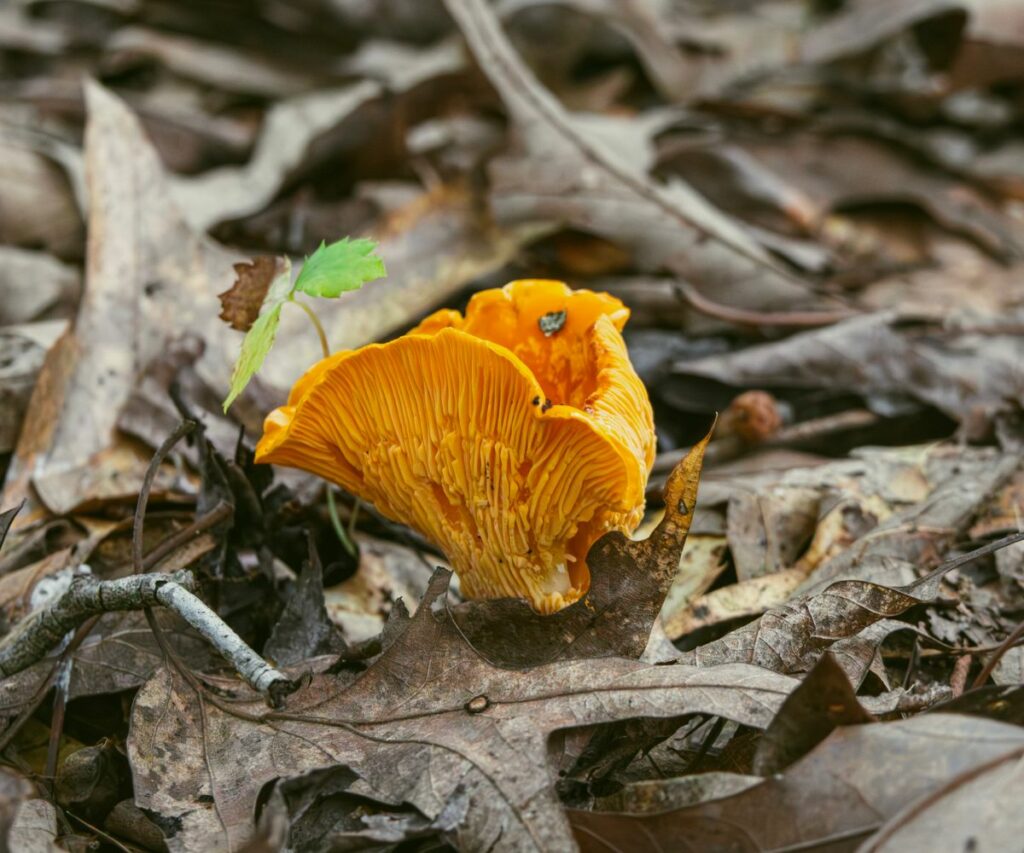
Jack-o-Lantern Mushroom
Jack-o-lanterns are another mushroom that can look like chicken of the woods from far away. With bright orange colors, they can draw in hopeful foragers like moths to a flame — don’t get fooled. These mushrooms feature small, individual caps rather than fan-shaped brackets or shelves.
The caps attach to distinct stalks that may be several inches long, eventually clustering at a single stem base. In contrast, remember that chicken of the woods does not have distinct stems. Jack-o-lanterns are not polypores; they have true gills that fan when touched and are the same bright orange color as the caps.
If you find it: Don’t eat it. Jack-o-lanterns are toxic and can cause symptoms like gastrointestinal distress, dizziness, and vomiting.

